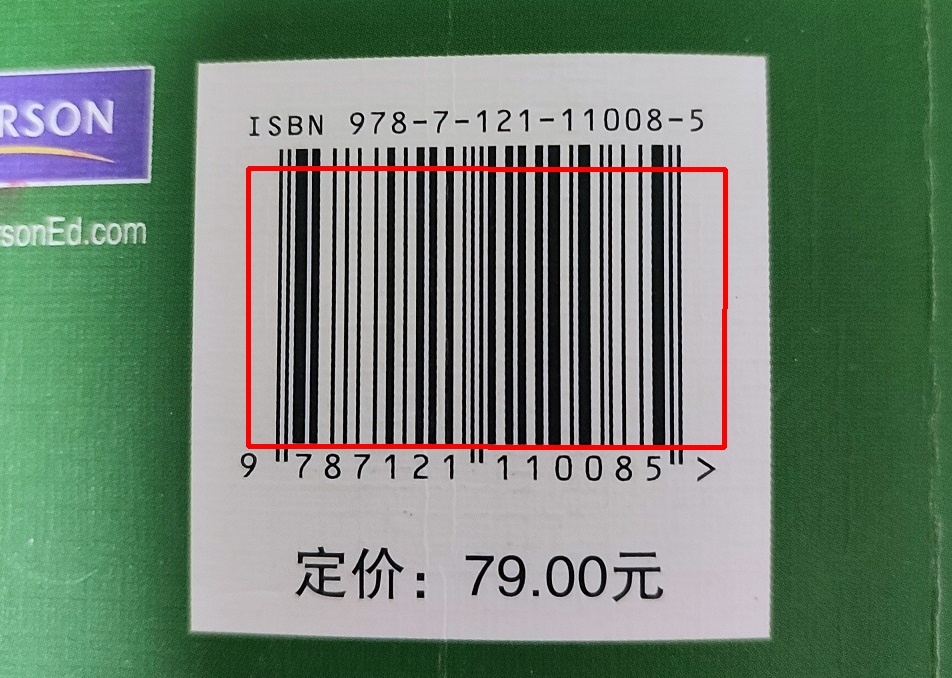原文链接:http://www.juzicode.com/opencv-note-barcodedetector-qrcodedetector
在 zbar:给我来10G打码图片 一文中桔子菌介绍了怎么用pyzbar识别条码和二维码的方法,今天我们聊聊怎么用OpenCV检测和识别条码、二维码。
1、BarcodeDetector 识别条形码
OpenCV在V4.5.3版本的contrib包中提供了一个barcode::BarcodeDetector类,用这个类可以实现条形码的识别,不过目前仅支持EAN13编码的条形码,其他类型的条形码在当前版本的BarcodeDetector还不支持。
在Python中使用,需要先安装opencv的contrib包:
pip install opencv-contrib-python导入模块时无差异仍然使用import cv2。
下面我们来看下具体的使用过程,首先创建一个条码检测实例:
import cv2
detect_obj = cv2.barcode_BarcodeDetector()然后用detectAndDecode()方法检测和识别条码,该方法将检测条码的存在和识别条码封装在一起:
img = cv2.imread("bar.jpg")
is_ok, bar_info, bar_type, points = detect_obj.detectAndDecode(img)返回的结果包含4个元素,分别是是否检测到条码、识别的条码信息、条码类型和条码位置:
print('is_ok:',is_ok)
print('bar_info:',bar_info)
print('bar_type:',bar_type)
print('points:',points)运行结果:
is_ok: True
bar_info: ['9787121110085']
bar_type: [2]
points: [[[248.0772 446.5566 ]
[248.50542 168.47102]
[725.2236 169.20511]
[724.79535 447.2907 ]]]这其中条码位置包含了4个元素,代表了检测到的矩形框的4个角的坐标。
利用这些坐标可以在图像中标注识别到条码位置:
for pos in points:
color=(0,0,255)
thick=3
for p in [(0,1),(1,2),(2,3),(3,0)]:
start = int(pos[p[0]][0]),int(pos[p[0]][1])
end = int(pos[p[1]][0]),int(pos[p[1]][1])
#print(start,end )
cv2.line(img,start,end,color,thick)
cv2.imshow('img',img)
cv2.imwrite('bar-detect.jpg',img)
cv2.waitKey()
cv2.destroyAllWindows()
当然上述检测方法detectAndDecode()也可以拆分成2个步骤进行,第1步先用detect()检测是否有条码:
img = cv2.imread("bar.jpg")
is_ok, points = detect_obj.detect(img)
print('is_ok:',is_ok)
print('points:',points)运行结果:
is_ok: True
points: [[[248.0772 446.5566 ]
[248.50542 168.47102]
[725.2236 169.20511]
[724.79535 447.2907 ]]]第2步将检测到的points传入decode()方法进行识别:
is_ok, bar_info, sn_type = detect_obj.decode(img,points)
print('is_ok:',is_ok)
print('bar_info:',bar_info)
print('bar_type:',bar_type)运行结果:
is_ok: True
bar_info: ['9787121110085']
bar_type: [2]标注识别到的条码位置和前面一样,这里不再重复。
2、QRCodeDetector 识别二维码
OpenCV中的QRCodeDetector类可以实现二维码的检测,QRCodeDetector类在OpenCV的3.0版本中就已经出现了,而且是在正式库不是contrib库中。
首先用QRCodeDetector()创建实例:
import cv2
detect_obj = cv2.QRCodeDetector()然后将图像传入到detectAndDecode()方法中检测和识别:
img = cv2.imread("qr.jpg")
qr_info, points, qr_img = detect_obj.detectAndDecode(img)返回的结果包含3个元素,第1个为识别的二维码信息,utf8格式的字符串;第2个为检测到的位置,包含4个点;第3个为二值化后的二维码,尺寸较原图更小。
print('qr_info:',qr_info)
print('points:',points)
print('qr_img.shape:',qr_img.shape)
cv2.imshow('qr_img',qr_img)
cv2.waitKey()
cv2.destroyAllWindows()运行结果:
qr_info: http://weixin.qq.com/r/Ejr54d-EkYLurZuC928A
points: [[[ 74. 74.]
[308. 74.]
[308. 308.]
[ 74. 308.]]]
qr_img.shape: (37, 37)这其中位置points包含了检测到的二维码位置,每组包含4个元素,代表了检测到的矩形框的4个角的坐标。用这些坐标可以在图像中标注识别到条码位置:
for pos in points:
color=(0,0,255)
thick=3
for p in [(0,1),(1,2),(2,3),(3,0)]:
start = int(pos[p[0]][0]),int(pos[p[0]][1])
end = int(pos[p[1]][0]),int(pos[p[1]][1])
#print(start,end )
cv2.line(img,start,end,color,thick)
cv2.imwrite('qr-detect.jpg',img)
cv2.imshow('img',img)
cv2.waitKey()
cv2.destroyAllWindows()
也可以用2个步骤分开执行,先用detect()方法检测,返回是否检测到二维码,以及二维码的位置:
img = cv2.imread("qr.jpg")
is_ok, points=detect_obj.detect(img)
print('is_ok:',is_ok)
print('points:',points)运行结果:
is_ok: True
points: [[[ 74. 74.]
[308. 74.]
[308. 308.]
[ 74. 308.]]]再用decode()方法识别,传入图像和上一步检测的二维码位置,返回的结果包含二维码信息和二值化后的二维码图像:
qr_info, qr_img = detect_obj.decode(img,points)
print('qr_info:',qr_info)
print('qr_img.shape:',qr_img.shape)
print('qr_img:',qr_img)运行结果:
qr_info: http://weixin.qq.com/r/Ejr54d-EkYLurZuC928A
qr_img.shape: (37, 37)
qr_img: [[ 0 0 0 ... 0 0 0]
[ 0 255 255 ... 255 255 0]
[ 0 255 0 ... 0 255 0]
...
[ 0 255 0 ... 255 0 0]
[ 0 255 255 ... 255 255 255]
[ 0 0 0 ... 255 255 0]]另外需要注意的是detectAndDecode()只能用来检测图像中只有1个二维码的情况,当图像中有多个二维码时,它的返回值qr_info为空字符串。
如果不确定图像中是否有多个二维码,可以用detectAndDecodeMulti()方法检测可能的多个二维码:
import cv2
detect_obj = cv2.QRCodeDetector()
img = cv2.imread("qr-multi.jpg")
is_ok, qr_info, points, qr_img = detect_obj.detectAndDecodeMulti(img)
print('is_ok:',is_ok)
print('qr_info:',qr_info)
print('points:',points)
print('qr_img:',qr_img)运行结果:
is_ok: True
qr_info: ['this is a test image', 'www.juzicode.com vx: juzicode']
points: [[[531. 127. ]
[796. 127. ]
[796. 392. ]
[531. 392. ]]
[[ 73. 75. ]
[405.00003 75. ]
[405.00003 406.99997]
[ 73. 407. ]]]
qr_img: [array([[ 0, 0, 0, ..., 0, 0, 0],
[ 0, 255, 255, ..., 255, 255, 0],
[ 0, 255, 0, ..., 0, 255, 0],
...,
[ 0, 255, 0, ..., 0, 255, 0],
[ 0, 255, 255, ..., 255, 255, 0],
[ 0, 0, 0, ..., 0, 0, 0]], dtype=uint8), array([[ 0, 0, 0, ..., 0, 0, 0],
[ 0, 255, 255, ..., 255, 255, 0],
[ 0, 255, 0, ..., 0, 255, 0],
...,
[ 0, 255, 0, ..., 255, 255, 0],
[ 0, 255, 255, ..., 255, 0, 255],
[ 0, 0, 0, ..., 255, 0, 0]], dtype=uint8)]detectAndDecodeMulti()方法返回包含4个元素的元组,第1个为是否检测到二维码,第2个为检测到的二维码信息,第3个为二维码边角的4个点,第4个为二值化处理后的二维码图片,后面3个元素均为list类型。
扩展阅读:
- zbar识别条形码和QR二维码
- OpenCV: cv::barcode::BarcodeDetector Class Reference
- OpenCV: cv::QRCodeDetector Class Reference
1、一副图像里仅包含一个二维码,使用 detectAndDecode 可以解读出来;使用 detectAndDecodeMulti 却解读为空,即未识别出来。
2、一副图像里包含4个二维码,使用 detectAndDecodeMulti 仅解读出来一个,其他3个中1个正确识别出二维码区域,另2个二维码区域都是错误,错位的。
如何优化下,谢谢。
可以尝试用opencv做预处理后再用detectAndDecodeMulti 或detectAndDecode检测识别。